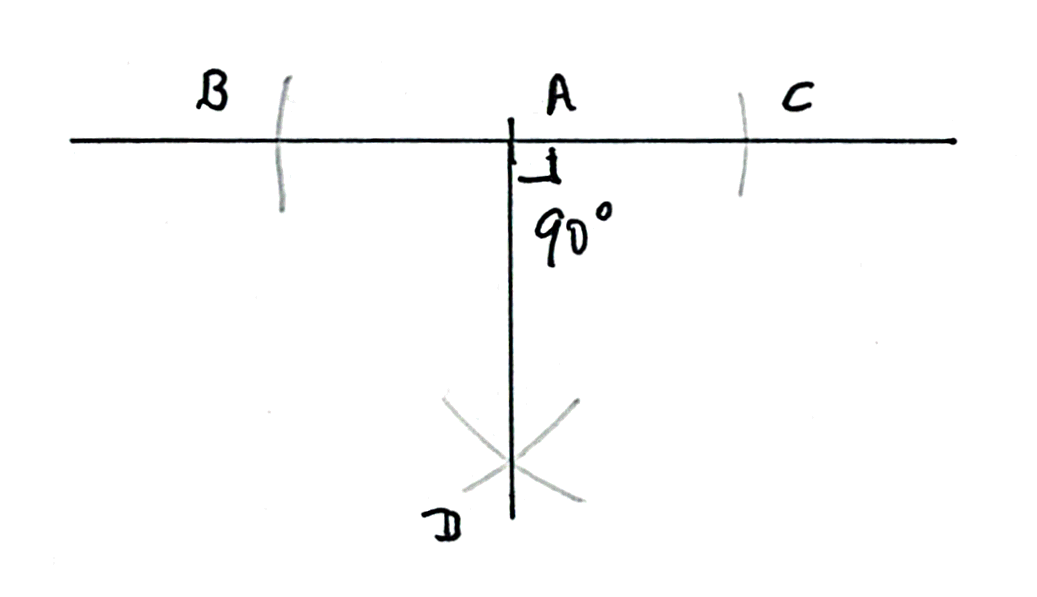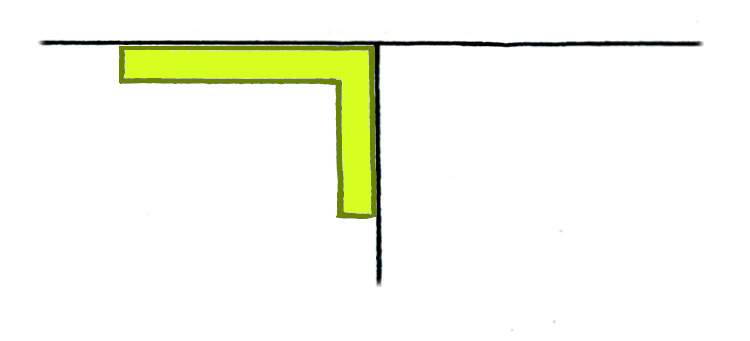
 Recommend to StumbleUpon
Recommend to StumbleUpon
How hard can it be? (Not very!)
What's the big deal?
The "big deal" is realizing that there is more than one answer.
"More than one answer??" you ask.
Yes- depending on how big the line needs to be, how accurate and/ or precise you want it, there are different "answers" that are best... for a given want.
Suppose you already have the upper line, the horizontal one. And you want a line downward from A.
Get a compass... the draw- a- circle type.
Set the arms so that you can put the point of the compass at A, and draw the small arcs which are near the B and the C of the diagram. Where the arc crosses the horizontal line is where B and C are.
It doesn't matter exactly how far B is from A, as long as C is the same distance from A as nearly as you can achieve it. And with a little care with the compass, you get a good result.
Now spread the arms a bit wider, and put the point of the compass on B. Draw the first of the two arcs you see below A. (Near the point marked D).
Keeping the compass arms as close to exactly as they were just now, move the point of the compass to C, and do the other small arc near D.
Draw a line from A to where the two arcs cross. That line will be perpendicular to the first line... if you worked caredfully enough.

Great! We've got one way to draw a perpendicular line.
But what if we want one about 40 cm long? And we don't have a big compass?
We could do it by drawing a small perpendicular, as we did before, and then making it longer. That would work... sort of.
But if we had a little error, say 15 cm from A, by the time we've extended the line out to 40 cm, the error will be bigger.
So here's the second of three ideas for you...
If you have a big carpenter's steel square, just use that to draw the perpendicular.
"Oh, gee... I never would have thought of that!"
Right. But would you have though of "flipping it around", as shown in the lower image? (One side of my steel square is painted lime-green, the other purple.)
If when you measure the line the second way, it still shows as perpendicular, then it is perpendicular. This is a check that your steel square isn't damaged and that you lined things up properly when you drew the line.


... but you still want to draw a long perpendicular, accurately?
Find a big piece of cardboard. If it doen't have a good straight edge, trim it, give it one. My piece of cardboard (in the image) was yellow on one side, blue on the other, and the shape was a bit wonky.
But I could still draw a perpenticular with it.
I lined the edge up with my first line, and made a mark on the cardboard where it was touching point A. (The mark is a small "^" in green. You'd be better off with a small line, but I wanted my mark for the diagram to be easy to see.)
The I made a mark at the bottom of the cardboard where I thought the perpendicular line would go past the piece of cardboard. I also made a small mark on my piece of paper.
And then... I flipped the piece of cardboard over. But before I lined it up in position again, I "carried" my two marks "around" the edge of the piece of cardboard. You can see them in mauve in the right hand diagram.
The top mark on the cardboard lines up with A because that's how I positioned the piece of cardboard.
The first time I do this while drawing a particular perpendicular, the mark on the bottom edge of the cardboard usually does not line up with the mark on the paper.
No problem... I "split the difference", make two new marks, (one on cardboard, one on paper), and flip the cardboard again. This time the two marks usually do line up. And so I have a point on the line perpendicular to the first line, and all that is left is to draw the line.... from A, to the second mark I made on the table.

... except to encourage you to think. If you do things "just" as explained above, you will get pretty good perpendiculars. But you think, and incorporate little tweaks, you can make the result really good. Where could errors creep in? How could you make it hard for them to happen?
Have you heard of Flattr? Great new idea to make it easy for you to send small thank you$ to people who provide Good Stuff on the web. If you want to send $$erious thank yous, there are better ways, but for a small "tip" here and there, Flattr ticks a lot of boxes which no one else has found a way to do yet. Please at least check out my introduction to Flattr, if you haven't heard of it? "No obligation", as they say!
Essay on Thomas Jefferson's code wheels from Flat Earth Academy.Search across all my sites with the Google search button at the top of the page the link will take you to.
Or...
Search just this site without using forms,
Or... again to search just this site, use...
The search engine merely looks for the words you type, so....
*! Spell them properly !*
Don't bother with "How do I get rich?" That will merely return pages with "how", "do", "I", "get" and "rich".
I have other sites. My Google custom search button will include things from them....
One of my SheepdogGuides pages.
My site at Arunet.
This page's editor, Tom Boyd, will be pleased if you get in touch by email.
![]() Page tested for compliance with INDUSTRY (not MS-only) standards, using the free, publicly accessible validator at validator.w3.org. Mostly passes. There were two "unknown attributes" in Google+ button code, two further "wrong" things in the Google Translate code, and similar in Flattr code. Sigh.
Page tested for compliance with INDUSTRY (not MS-only) standards, using the free, publicly accessible validator at validator.w3.org. Mostly passes. There were two "unknown attributes" in Google+ button code, two further "wrong" things in the Google Translate code, and similar in Flattr code. Sigh.